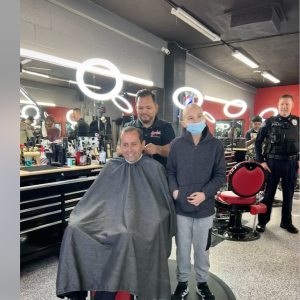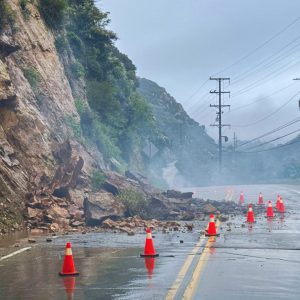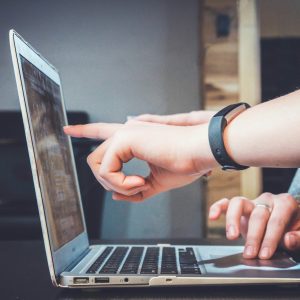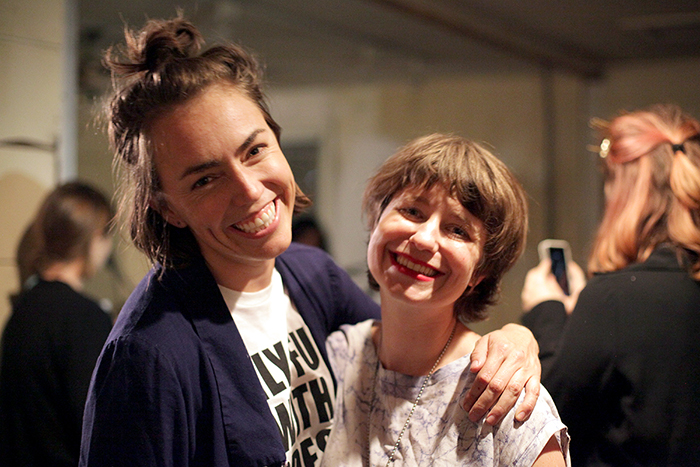 View Winners →
View Winners → A Q&A with the Women’s Center for Creative Work
“We’re in the business of saying yes.”
The Women’s Center for Creative work opened its doors in Frogtown in 2015 after springing up organically from a dinner party in 2013, and is now a thriving community of more than 7,000 followers working in various genres. We caught up with co-founders Sarah Williams and Kate Johnston on the origins of the non-profit feminist art space, the highlights and challenges of managing and growing a 100% volunteer-run organization, and how they keep the lights on.
So, how did you get started with the Women’s Center for Creative Work?
Sarah Williams, Managing Director: A few years ago, there was a show at OTIS called “Doin’ it in Public,” which was part of the Pacific Standard Time exhibitions that the Getty put on. It was about the Woman’s Building, which, even having studied Art History in college in a very liberal program, I had barely heard about. It ran from 1973 to 1991 in L.A. It was always presented as sort of a blip of feminist art, and there was so much great material and information, so many images that were really inspiring, that we were like, “What is this now? Where is this now? We want go there and be part of this!” And at that time, we didn’t see anything like it around.
Kate Johnston, Creative Director: Yeah, it was so exciting. The Woman’s Building was an institution that ran for twenty years. Finding this history that we didn’t know about and was happening in L.A. was fascinating. The Woman’s Building was started by three women — Judy Chicago, Arlene Raven and Sheila De Brettville — who are on faculty at CalArts. At the time, they felt like their students were making art about their bodies or motherhood, and the rest of their peers and faculty were just kind of dismissing their work. So they left and started this radical space.
Sarah: Which was the feminist studio workshop, or the school aspect of the radical pedagogical aspect of what was happening at the Woman’s Building. And that was awesome, but what we really got excited about was that it was like a bookstore, and a gallery, and a feminist travel agency, and that all of these things were sitting side by side.
Kate: Yeah, and they were all standing in solidarity together and sharing a rent bill, but totally autonomous. We really liked that idea, and it felt very feminist to us that you could work in tandem with someone but not have to feel like you need to tell each other what to do. All of those ideas were really exciting to us, so the three of us (along with Katie Bachler, who has since moved to Baltimore), just started talking about feminism. What is feminism right now? Why didn’t we know this history and why is it that people get weirded out by that word? Even people who are feminist artists will say they’re not feminists. We just wanted to talk about it! Katie at the time was living in the desert, outside Pioneertown, so we said, let’s have a party about feminism. It was called “Woman’s Dinner in the Desert” and we invited everyone we knew.
Sarah: Pretty much. We expected 30 people in a best case scenario, but 60 women came. We drove tables out to this dry wash and set it up. And it was really beautiful–just a magical and inspiring evening that felt very powerful. And once we finished that and cleaned up, everyone was like, “what’s happening next?”
Kate: So a couple of months later we did another dinner, called “Woman’s Dinner in the City.” We went to the actual Woman’s Building site, which is still standing. It’s kind of run down, and it’s now artist studios.

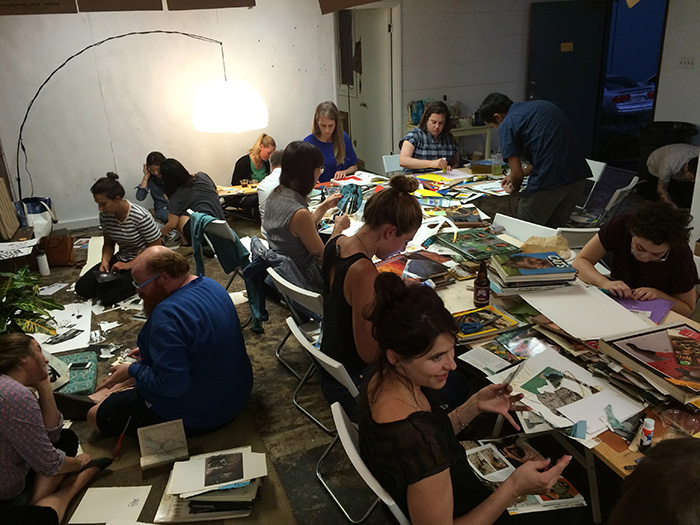
Is it Downtown?
Kate: Yeah, it’s on Spring Street, right before Lincoln Heights.
Sarah: We had a friend who has a studio in the Woman’s Building now, so she let us in. And there is still some artwork and murals and things left on the walls. So we went in and led tours of the building and read aloud some of the murals on the wall. We wanted to link ourselves to that history. And we ate a big meal there together — it was like 100 people.
Kate: It was crazy. We were like, “we’ll just do this thing,” but it was so intense how many people were interested and how many people wanted to come. So many people wanted to help. The enthusiasm was amazing, and it became really clear that this was something that needed to happen. So we just built the structure, and everyone made it happen. Which was really exciting. I still meet people and they’ll tell me that they met people they’re working with, or are best friends with now, at our events. It was almost like our audience propelled us become a thing. We became the Women’s Center for Creative Work proper after that dinner, because it just felt like there was such a need for a structure that facilitated these kind of things happening.
Sarah: So then after that dinner when we were trying to figure out what this thing was, we started this year-long laboratory project. Over the course of a year, broken up into four quarters, we looked at history (histories of feminist organizing practices), economies (how do people pay for these things), community (what is the community we want to serve, and how do we talk to other communities that are doing this kind of work), and space (thinking about what we wanted the space to be like). Luckily, what made that possible was the SPART grant, which gave us $10,000 to get into our space.
So, what do you tell people when they ask what it is and why you might come here? I know you do office share space and things like that. How does that work?
Kate: Well, WCCW’s mission is to cultivate L.A.’s feminist creative practices and communities. So when people ask, I tell them that, and then they’re like, “Ok.” But if they’re still listening, we have a feminist cowork space, we have professional development and skill-based programming, we have project incubation facilities, and we have a network that’s growing every day by like 10%. So those things really are all centered on the idea of work and labor. So it’s about the workspace and the network. Most of our workshops are skill-based, and then we have a whole curriculum of professional development to help people build their own creative business.
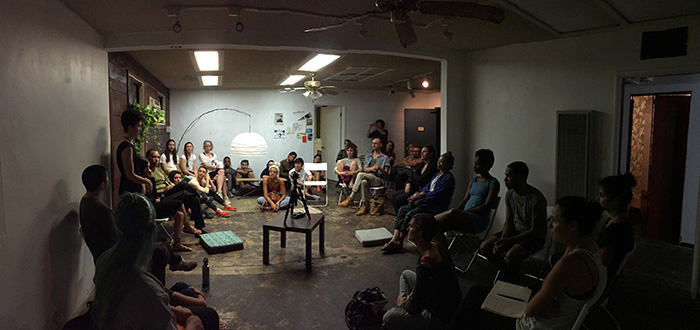
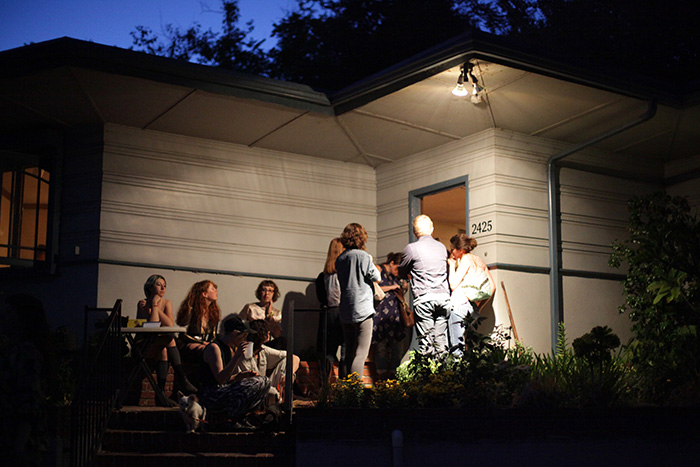
What kind of workers are you seeing?
Sarah: Lots of designers and writers. Fine artists. And dancers and performance artists. Who maybe aren’t using the workspace in that way, but who are interested in alternative places and ways of performing. Even a lot of like gardeners and food people, since we have a kitchen.
Kate: I think more than a specificity of practice, we get a certain kind of person. A lot of our audience is made up of people who just moved to L.A. from Oakland or somewhere, and they miss the community.
Sarah: Or they just got out of grad school or undergrad and don’t know what to do. Or they’ve been working in a field for a while but are frustrated that there are no women in their field.
Kate: We get a lot of educators too. People who have an entrepreneurial spirit and are trying to figure out what that means for them. Maybe they work a 9-to-5 but they don’t know what that is. So they come to our workshops and meet people who will be their collaborators.
So it sounds like where it’s proving especially worthwhile is in the networking.
Sarah: It’s a really strong component. And I think from the beginning it was obvious that people really wanted to meet and talk to other people who identify as feminists.
Right, and that’s historically been difficult.
Kate: Right. Like you have to be so intentional about community space. In LA, you’re not going to leave your house unless you’re going to a place. There’s no chance meeting on the street. And I think what we’re creating here, hopefully, is a place where you could have a chance meeting. Because people are coming and going, you could run into somebody and develop a friendship.
Sarah: My favorite days are when three things are happening back to back, because I hope it’s fun and that people meet each other. Even though they might be there for totally different things. I love overhearing people asking about different things in the workspace.
Yeah, that’s really cool. So is this your full time gig? Or what’s the hustle?
Kate: (Laughs) We wish! Somebody should come be our angel investor, we’d love that. Seriously, as of now, we are almost 100% volunteer run. I have a full time freelance graphic design practice.
Sarah: I work for ForYourArts, and I split my time between here and there, working on a lot of events and programming projects.
So if you’re both contract workers, you both have the ability to come and go from here then, right?
Sarah: Yeah, and we’ve both managed our situations that way, so that we have a little bit of flexibility to be in both places. But it’s hard.
Kate: I think we both do the thing we do here elsewhere for money. (Laughs.) We just have to do that right now, but hopefully some day that will change. Working in house somewhere has its benefits, but you could never do that and still be here a couple of hours a day. So it’s different.
Sarah: And of course we’d also love to pay people. It’s so much volunteer effort from so many people.
Kate: We have committees of people who do amazing things, like clean the kitchen.
Sarah: Even programming. We’re moving into a model where the programming committee will select most of that.
What are some things that have been really surprising as you’ve done this?
Kate: I am continuously surprised that this is working. From the one-off projects that we were doing in our spare time to this thing where people are coming in the door being like, “I’m so excited to be here.” Or people coming in crying and need a safe space. The fact that we get to sit in this office and know that that’s happening is so amazing everyday. I can’t believe it.
Sarah: Even when it’s super hard, that’s exciting, and really fulfilling. It’s a form of creative practice for us too.
Kate: Yeah. And it’s just exciting for us to work with people and to help them feel like they have a place in the world. You know, Los Angeles is hard. Like you just graduated and you’re working some office job but you really want to sing or whatever. (Laughs.) But what’s cool about this city is that there’s actually room for you to do that here more than in any other city, but you have to find somebody to say yes to you. And I think we’re in the business of saying yes.
***Editor’s Note: This story was originally published on Feb. 4, 2016.




























































